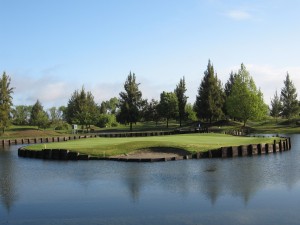
Trees, water, and wildlife characterize what was once a flat, barren, open field. Pictured is the island green on the par-3 17th hole.
You may never see the Bartley Cavanaugh Golf Course in Sacramento, California on any list of best or most famous golf courses, but quietly the layout is a success story and a model for the future.
With rising land and water costs, political snipes at the game, and misinformation offered by environmental obstructionists, growing the game has become increasingly difficult. This Sacramento City golf course recently celebrated its 15th Anniversary and is about to reach a million rounds of play. What’s more, it’s been an environmental benefit to the community.
The course was built on an 88-acre plot of flat, featureless land that was subject to flooding, had minimal wildlife, and was barely suitable for any other pursuit. Not only was this an ugly piece of property, it was tiny when considering that most golf courses have typically required 150 acres. Let golf and golf course architect Perry Dye step in for a most exciting and beneficial transformation.
Affectionately termed “the shoehorn architect” for his ability to imaginatively build viable courses into small sites, Dye (the older son of architects Pete and Alice Dye) practices and preaches the only model this writer sees as sustainable for the future.
At the Bartley Cavanaugh site Dye employed both a cut-and-fill strategy for creating the needed attractive water retention lakes and desired natural habitat areas, and took 800,000 cubic yards of waste fill that the government would have spent even more money to dispose of properly. Dye then used this dirt to create mounding and character to the course defining the look and play of each hole. (Look left of the fourth hole at the adjoining land and you may begin to imagine what Dye did to create the attractive landscape that now everyone enjoys.)
Dye next secured trees at bargain rates and planted them to create buffers between the holes. When I first played the course, I remarked that you needed a hardhat when playing there because golfers would miss the narrow fairways and land in adjoining ones. Now with the trees grown, the risk is mitigated and apparently the incident rate at the course is average. As an added bonus, the Course and surrounds have been lovingly administered so as to gain honors as a Audubon certified golf course. Reflecting how the Bartley Cavanaugh Golf Course enhances and protects the environment is quite an honor considering that less than 5% of the nation’s 16,000 golf course have made the grade.
The other thing about creating a sustainable golf course is to preserve water resources. The putting surfaces at Bartley Cavanaugh are smooth and uniform while the fairways are nicely manicured, but they are also brown and firm. Brown and gray are the new beautiful colors and will be featured more in the future. They allow for the bump-and-run game, which tends to be more interesting. This is not an old idea, but somewhere along the line, American golf contracted the hideous disease, Augusta-itis, and the “green disease” spread. Anyway, water is conserved at Bartley Cavanaugh and the conditions are fast and firm though smooth and uniform.
The net result is that the Bartley Cavanaugh Golf Course is a fun, attractive layout. Measuring just over 6,000 yards from the tips, the premium is on accuracy and not length. The course is very playable with no forced carries with the exception of the trademark short par-3 island green 17th hole. The landscaping has matured nicely and not only does this golf operation support the local economy and provide employment opportunities, but the course offers wonderful recreation at very, very reasonable prices. With its contributions including being a good steward with the environment, you can appreciate why the Bartley Cavanaugh Golf Course is a model for future golf development.
Fagan Grade: C. The grade of “C” reflects a solid, average, entertaining golf course in good condition, albeit rather short and tight. What the City of Sacramento and Perry Dye did to transform the property and make it both sustainable and a good value rate a “A.”
